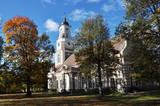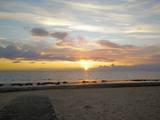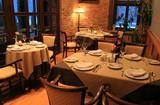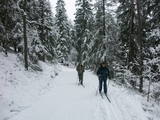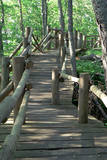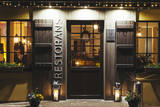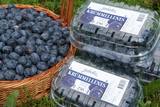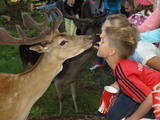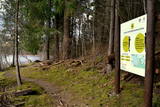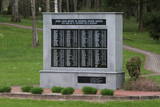| Nr | Name | Beschreibung |
|---|---|---|
|
Это один из 6 маршрутов путешествий в серии «Насладитесь деревней!», который приглашает посетить «Дары села» – хозяйства и предприятия всевозможных видов и отраслей, которые открыты для посетителей и предлагают экскурсии, попробовать, осмотреть и приобрести свои изделия. Там можно увидеть домашних животных, современные сельские хозяйства, мастерские ремесленников, приобрести сельскохозяйственные продукты – хлеб, мед, домашнее вино и пиво, сыр, ягоды, фрукты, рыбу, мясо, овощи, чаи и другие, выращенные в деревне дары. По дороге можно отобедать в сельских корчмах. Примерное время прохождения маршрута: три - четыре дней, в зависимости от количества выбранных достопримечательностей и времени, отведенного для их осмотра. |
||
|
Die Kirche wurde in der Zeit des Barons Otto Hermann von Vietinghoff von 1781 bis 1788 nach dem Projekt des Architekten Christoph Haberland im Stil des Klassizismus mit barockalen Stilelementen und einem bunten Mosaik aus Feinsplitt an der Fassade des Gebäudes gebaut. Die Kirchenorgel wurde 1855 von Augusts Martins eingerichtet. Die Kirchenglocke wurde während des Ersten Weltkriegs nach Russland gebracht und anstelle dieser Glocke wurde eine 1530 gegossene Glocke aufgehängt. Das Altarbild (der Autor ist unbekannt) “Die Taufe Jesu” ist 2000 erneuert worden. In der Mitte des 19. Jahrhunderts waren in der Gemeinde von Alūksne viele Esten, deswegen wurden die Gottesdienste auch auf Estnisch gehalten. Die Wiederaufbauarbeiten der Kirche wurden 1934 unter der Leitung vom Architekten P. Kampe geführt. Zurzeit ist ein festes Gebäude mit einem 55,5 m hohen Turm eine der Dominanten der Stadt. |
||
|
Als die größte Ortschaft begann sich Saulkrasti am Ende des 19. Jahrhunderts zu bilden, wenn kleine Fischerdörfer – Neibāde, Pēterupe und Katrīnbāde zum populären Erholungs- und Badeort der Rigenser wurden. Das hat sich rasch den Bau der Sommerhäuser beigetragen. Auf die Entwicklung des Kurorts hat sich auch den 1905 eröffneten Schiffsverkehr zwischen Rīga und Saulkrasti ausgewirkt. Es wurden neue Kurhäuser, Restaurants gebaut und eine andere mit dem Kurort verbundene Infrastruktur entwickelt. Zur Verfügung der Besucher standen in der Sommerzeit verschiedene Veranstaltungen, Bälle und Konzerte mit dem Teilnahme der Orchester aus Rīga. Die nächste Etappe der Entwicklung des Kurorts waren eine in den 30er Jahren des 20. Jahrhunderts gebaute Automobilstraße und eine Eisenbahnlinie zwischen Rīga und Saulkrasti. In der Sowjetzeit wurden Erholungshäuser, Sanatorien und neue Sommerhäuschen gebaut. Saulkrasti wird eine Stadt. Heutzutage lockt die Stadt Saulkrasti nicht nur durch den weißen Sandstrand, sonder auch durch verschiedene jährliche gesellschaftliche Veranstaltungen, den Pfad des Sonnenuntergangs und die Weiße Düne, das einzigartige Fahrradmuseum von Saulkrasti, den Meerespark und die Badestelle „Centrs”, den Saules Platz u.a. Objekte an. |
||
|
National partisans commanded by Rihards Pārups were very active during World War II between Vietalva and Jaunkalsnava. The team was disbanded in 1946. The dugout is at a location that is hard to find and access. It is in the nature reserve of the Veseta Wetlands Swamp. The wood pathway that leads from the East is often hidden by reeds during the summer. During the fierce winter of 2010, the roof of the dugout collapsed, but local enthusiasts plan to reconstruct it. Alongside the dugout is a white cross inscribed with the names of the partisans who lost their lives here.
|
||
|
Im historischen Zentrum von Vecgulbene, in einer restaurierten Reithalle des Landguts, die früher die größte geschlossene Reithalle im Baltikum war, befinden sich ein 4-Sterne-Hotel und ein Restaurant. Es werden ein vielfältiges saisonales Menü und Geschäftsessen angeboten. Lettische Küche: Kalte Sommersuppe, Steak aus Lammschenkel, geschmorter Kaninchenschenkel, gebratener Entenschenkel, Erdbeersuppe mit Eis. |
||
|
Valmiera ist in den historischen Quellen zum ersten Mal 1323 erwähnt worden. Bis zum 13. Jh. gehörte diese Ortschaft zu dem von den Letgallen bewohnten Land Tālava. Mit dem Bau der mittelalterlichen Burg wurde am Anfang des 13. Jhs. begonnen, aber um 1283 wurde zwischen den Flüssen Gauja und Rāte eine Kirche gebaut. Die wirtschaftliche Entwicklung der Ortschaft hat die Nähe der Handelswege von Pleskau und Dorpat-Novgorod gefördert. Vom 14. bis 16. Jh. gehörte Valmiera zur Hanse. Die Stadt hat sehr stark unter den Kriegen, Seuchen und Bränden zwischen dem 16. bis 18. Jh. gelitten. In der zweiten Hälfte des 19. Jhs. begann die Stadt wieder wirtschaftlich aufzublühen. Die Entwicklung förderte auch die im Jahr 1866 gebaute Brücke aus Holz über den Fluss Gauja und die im Jahr 1899 eröffnete Eisenbahnlinie Riga-Pleskau. Im Jahr 1944 wurde das historische Zentrum der Stadt zerstört. In den Nachkriegsjahren haben in der Stadt große Industrieunternehmen gearbeitet, z.B., Glasfaserunternehmen (arbeitet noch heute). Heute ist Valmiera das Wirtschafts-, Bildungs- und Sportzentrum der Region Vidzeme. |
||
|
Der Naturpark von Ogre ist ein beliebter Ort für Freizeit, Wandern und im Winter für Skilanglauf. Der größte Teil des Parks ist mit Nadelwald bedeckt, der sich auf einer langen und vergleichsweise schmalen Linie von Hügeln mit steilen Abhängen befindet – ein weiteres Element der in Lettland von der Eiszeit zurückgelassenen Natur. Man findet hier viele verschiedene Pflanzen. Der Jaunogres-Burgberg ist einer der ausgeprägtesten Hügel in diesem Gebiet.
|
||
|
Augstrozes pilskalna taka atrodas ainaviskā vietā, gleznainā 13. gadsimta pilskalnā, kas apvīts ar teikām un leģendām. No pils drupām paveras labākais skats uz lielisko ainavu, ko veido Augstrozes Lielezers un Ziemeļu purvi.
|
||
|
Die Route ist für aktive Fußgänger geeignet, die auf ihrer Reise sowohl Landschaften, als auch die Gefühle des Tales des eindrucksvollsten Flusses der baltischen Länder genießen möchten. Die Route beginnt in Sigulda, die historisch als die Schweiz der Region Kurzeme genannt wurde. In der Umgebung von Sigulda kann man einige der schönsten Landschaften Lettlands genießen. Die Route überquert mehrere tiefe Täler der Nebenflüsse von Gauja und legt die Ufer des Flusses frei, die im Baltikum mit seinen Sandsteinfelsen der Devonperiode bekannt sind. Die Naturpfade von Līgatne ist der einzige Ort in Lettland, wo in waldiger Umgebung, unter naturnahen Umständen und in großen Pferchen unseren Wäldern charakteristische Tierarten wohnen, die Besucher besichtigen können. Aber Tiere und ihre Fußabdrücke kann man auch besichtigen, wenn man auf den Naturpfaden und in den Wäldern des Nationalparks Gauja wandert. Route information from Latvijas Lauku forums |
||
|
Ein kleines, ruhiges und gemütliches Hotel mit einem Gourmetrestaurant befindet sich an der Landstraße Riga-Tallinn in Ainaži, wo die Luft nach Kiefern und Meer riecht. In der gemütlichen Atmosphäre des Restaurants kann man ein leckeres Essen genießen und die Nähe zur Natur verspüren. |
||
|
Some 250 deer graze on 100 ha of land in the Umurga Parish. The farm also offers a look at peacocks, rabbits, sheep, goats and a pony. Biological products are on sale, and visitors are welcome all year round.
|
||
|
This beautiful farm near the hillocks of Lake Kālis grows raspberries, strawberries, cranberries and blackberries. During the season, you can pick, taste and buy the berries. Informational tours are also available. |
||
|
Ein Mosaik an Schilfflächen, Küstenwiesen, Lagunen, morastigen Seen und sandigen Flachgewässern liegen versprenkelt an der Küste der Rigaer Bucht zwischen Ainaži und Kuiviži. Ein geschütztes Reservat und Naturschutzgebiet. Vogelbeobachtungsturm und Naturpark. Die Objekte befinden sich im Biosphärenreservat Nordlivland (Ziemeļvidzeme).
|
||
|
Cecīļu dabas taka ir kājāmgājēju tūrisma maršruts, kurā ir iespēja iepazīt Amatas novada dabas objektus gar Kumadas upes, Dančupītes un Amatas upes krastu. Takas sākuma punkts ir Amatas novada Ieriķos, 1 km no kafejnīcas, degvielas uzpildes stacijas, Cecīļu dabas takas apmeklētāju centra, blakus autoservisam. Apmeklētājiem ir iespēja izbaudīt cilvēka nepārveidotu dabas ainavu – Dančupītes kanjonu, minatūru ūdenskritumu, no Kumadas upes labā krasta aplūkot iespaidīgo Cecīļu iezi un citus objektus. Taka ir marķēta. |
||
|
Some 200 fallow deer live in large paddocks at the park, and the largest deer sorting facility in the Baltic States is right next door. You can look at the animals from up close. The owner organises educational camps for children and offers consultations on the breeding of animals. |
||
|
Takas sākums atrodas pie Veclaicenes pagasta pārvaldes (autosvālaukums). Tā izlokas gar Ievas, Trumulīša un Raipala ezeru dienvidu krastiem un pa ziemeļu krastu nogāzēm atgriežas atpakaļ sākumpunktā. Apļveida takas garums – ap 8 km. Atrodas Augšzemes aizsargājamo ainavu apvidū, Kornetu – Peļļu subglaciālajā vagā. |
||
|
Befindet sich am Rande der alten Straße Alūksne – Ape, unweit von der Ortschaft Karva. Das Denkmal wurde am 12. November 1937 eröffnet. Das Denkmal wurde nach einem Entwurf des Architekten V. Vitands errichtet. Auf dem Denkmalsockel ist die Inschrift angebracht: “Die im Lettischen Unabhängigkeitskrieg 1919 gefallenen Krieger des Regiments von Valmiera. Auf der Grenze habe mein Leben bei der Verteidigung der Heimat gegeben”. Das Denkmal wurde 1975 zerstört, aber 1994 erneuert. |
||
|
Oranžērija Bekuciems ir ģimeniska svinību vieta 40 min braucienu attālumā no Rīgas, Tomes pagasta Bekuciemā. Šeit ir iespējams svinēt savus dzīves skaistākos notikumus - kāzas, krustabas, dzimšanas dienas, bērniņa raudzības, fotosesijas, atpūsties pie dabas, gatavot ēst un pašiem saklāt skaistu svētku galdu, organizēt korporatīvos pasākumus, iepazīstināt ārzemju tūristu grupas ar latviešu tautas tradīcijām un dzīvesveidu. Oranžērija ir apsildāma un darbojas visu gadu. Tās platība ir 4x6m un tajā ērti var justies nelielas kompānijas līdz 15 personām. Tā ir pilnībā aprīkota ar visu nepieciešamo atpūtai - mēbelēm, traukiem, galda piederumiem, kafijas aparātu un tējkannu, bezvadu bluetooth skaļruni, ledusskapi, plediem, svečturiem, svecēm, vāzēm, bērnu barošanas krēsliņi utt. Ap oranžēriju ir plaša teritorija, kurā var atpūsties liels skaits cilvēku. Te irpļavas, dīķis, āras atpūtas vieta, pirts un pirts nojume, grils, kūpinātava, ugunskura vieta un ugunskura zupas vieta, pļavas altāris, bērnu spēļu laukums, pļavas futbols, āras labierīcības. Blakus ir sēņošanas un pastaigu vietas Bekuciema slavenajos mežos. No saimnieces vasaras sezonā var sarunāt zaļumus, garšaugus un zāļu tēju. |
||
|
Ein altes, von Liven schon vom 5. – 6. Jh. bewohntes Gebiet. Im Jahr 1226 hat der Bischof Albert in der Mündung des Flusses Salaca am rechten Ufer eine Burg gebaut, die sich bis heute nicht erhalten hat. Auch die Entwicklung von Salacgrīva (ähnlich wie von Ainaži) war mit der Bildung des Hafens verbunden. In der Jahrhundertwende 19.-20. Jh. wurde Salacgrīva zu einem bedeutenden Transport- und Umladungsknoten für die in Nord-Vidzeme hergestellten Waren (besonders für Holz). Während der Sowjetzeit wurde im nördlichen Teil von Salacgrīva der Park Zvejnieku parks (Fischerpark) mit einem der besten Stadien der lettischen Kleinstädte und mit einer Freilichtbühne eingerichtet. Während dieser Zeit ist auch in der ganzen Sowjetunion die Produktion – besonders die Sprotten – der Fischverarbeitungsfabrik Brīvais vilnis bekannt. Salacgrīva ist einer von den zwei Orten in Lettland, wo die Neunaugen immer noch mit der alten Methode – mit den Fischzäunen – gefischt werden. |
||
|
In der Zeit des Zweiten Weltkrieges – Ende des Septembers im Jahr 1944 spielte sich in More eine von der blutigsten und grausamsten Kämpfe im Territorium Lettlands ab. Noch grausamer waren nur die Kämpfe im sogenannten „Kessel von Kurland” (Kurzemes katls). In der Kämpfen von More haben die auf der Seite Deutschlands kämpfenden lettischen Legionäre den Durchbruch der Roten Armee nach Riga verhindert, als auch die Einkreisung des deutschen Truppenteils 18 abgewehrt. Das Resultat der Kämpfe war wichtig für die örtliche Bevölkerung, (> 100 000), die Menschen könnten noch fliehen und solcherweise der späteren Repressionen entfliehen. Jedes Jahr wird hier im September Gedenkfeier gefeiert. Hier sammeln sich sowohl Augenzeuge dieser Vorgänge, als auch andere Interessenten. Hier wurde eine Memorialwand mit Namen der Legionäre, als auch einen in Stein gemeißelten Kreuz – das Gedenkzeichen für alle nicht identifizierten Gefallenen aufgestellt. 2 km östlich von dem Park ist ein Museum eingerichtet. Neben diesem Museum kann man einen sowjetischen Panzer besichtigen.
|
||

